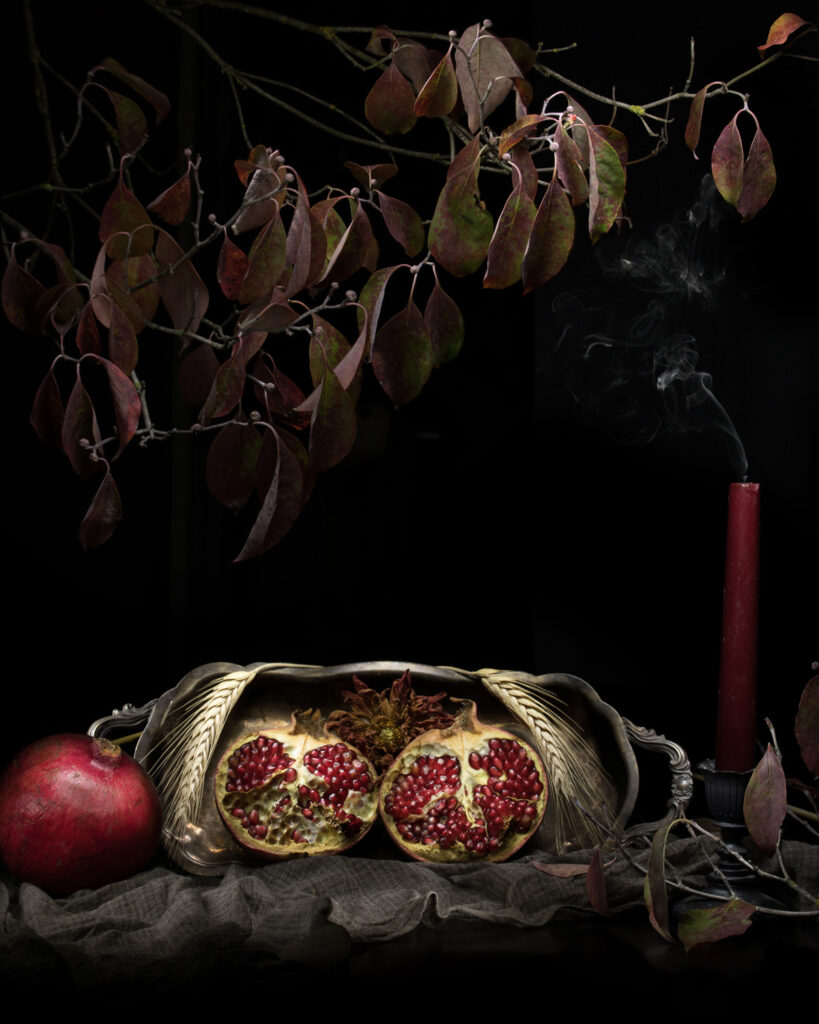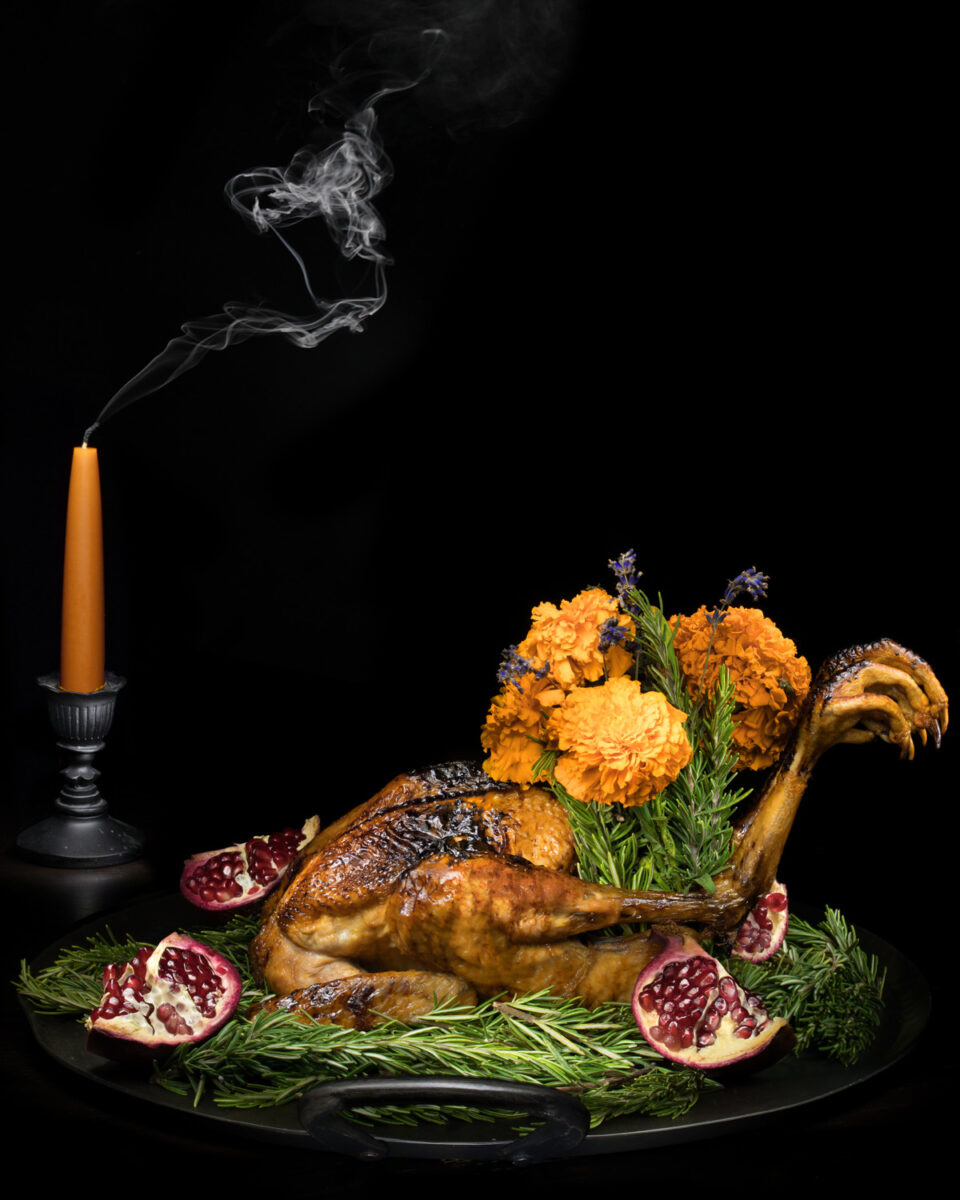I thought about calling this dish “terrifying chicken” as it may strike fear into the hearts of some. But this is a highly subjective truth. North Americans, my self included, are so conditioned to disassociate the meat we are eating from the animal it came from. This, I believe, is why the boneless skinless chicken breast is the most in-demand and ubiquitous cut of the bird in this country – despite it being the least flavorful and most likely to dry out as the muscle fibers contract. I too started my culinary adventures cooking with it, it meant I didn’t have to think about the animal it came from or deal with any home butchering whatsoever. Even cutting off a bit of fat was a negative prospect for me. Then as time when on, I started to roast whole birds, primarily turkey or chicken at Thanksgiving. I remember it really clicking how the drumstick connected to the thigh, how the thigh connected the back and how chicken wings separated into tips, drums and flats. I remember how revolted I was as a kid when my dad would break open the bones of his wings and suck out the marrow. As time went on I became desensitized, or so I thought, to the anatomy of the chicken. I could break down a raw whole bird, make pâté from their livers or even sample a skewer of yakatori grilled hearts. Then while living in LA I decided I was going to make my first ramen broth from scratch. I wasn’t looking for a thin assari style but a rich kotteri like a tonkotsu, though I don’t eat pork. It was recommended to me that I make the broth using chicken feet, with so much collagen and connective tissue they would render the broth cloudy, gelatinous and silky. So out I went to the local Mexican market to pick myself up some chicken feet. I was successful, and returned to make my broth. I was struck with how talon-like they where, reminding me that birds are no more than dinosaurs who evolved small enough to lift themselves off the ground. I tried not to look as I drained the broth and discarded the feet for fear of losing my appetite. The broth was delicious, soothing and lovely. Yes, the ends had absolutely justified the means. The only reason I they are not my go-to for making stock is that organic ones are so hard to come by. I learned subsequently that in Chinese culture the feet are often fried up and eaten by themselves, and chicken breast is considered a far less favorable part of the bird. The Eastern sensibility is that crispy bones and connective tissue are much more palatable than fibrous, often flavorless breast meat. Something about that makes sense.
What I’m trying to say is that the macabre is a subjective thing. If I was trying to spook an eastern audience with my cooking I’m not sure it would be possible. However as a Westerner I am able to coax out a little bit of drama with this Halloween showstopper.
The visual inspiration behind this dish came from Daniel Humm’s Roast Chicken for Two at The NoMad in NYC. Though I’ve not had the good fortune to try it myself, the aesthetic is definitely arresting. The presentation contrasted the macabre silhouette of the feet-on bird with a luscious herb bouquet placed in between its legs. The entree is very much a gilded lily. Foie Gras and black truffle piped under the skin, butter basted and brought to the table for a peak only to have it whisked away moments later for carving and to finish cooking the legs. I thought about trying a slightly less expensive version with chanterelles and chicken liver pâté, but at the end of the day the thing that struck me about the dish was the look, and that is what I sought to replicate.
Finding a poulet-avec-pieds in this city however proved somewhat more difficult than expected. Naively, I started by calling every butcher shop in town. Surely at least one of them would be breaking down whole birds themselves. And yet, all of them informed me they received their whole birds in their final form. It makes sense now that the NoMad had their task cut out for them, arranging with their amish farmers at the source to receive their birds intact. A particularly helpful butcher confirmed what a friend had predicted, my best bet was a Chinese supermarket. I found success at the Fubonn market out on 82nd. But there was one caveat – they came with the head on as well. Perhaps a final test to my post-mortem avian sensibilities, could I really decapitate the animal while it was staring back at me, judging me? In the 7th grade, after learning about the callous evils of factory farming, I came home to my mother and told her I would no longer be eating meat. “The hell you aren’t!” was the sentiment returned to me by the resident cook and provider of my meals. Somehow we came to the compromise that I would continue to accept poultry and fish, and that’s how it stuck. Now, as I stared back at the poultry I was about to decollate, a certain irony was not lost on me. But, the show must go on, and so it did.
The next step was to brine the beast. Since I would not be carving the bird and giving the legs a final sear like the cooks at The NoMad, I had to make sure the legs could reach the proper temp, around 170F, without the breasts overcooking and drying out. The best way to do this, I have learned over the years, is a solid wet brine. The salt breaks down the muscle fibers so they don’t contract and squeeze out the moisture while roasting. I prefer a quick brine at a high percentage for the sake of time, also I feel it yields a better result. You need a kitchen scale to get the ratio right, 10% salt by weight. I boil half the water with some aromatics and all of the salt. Then I dilute the solution by half with cold water so I don’t have to wait for things to cool down before submerging the bird. It goes in for 2 1/2 to 3 hours, any longer and you risk over-seasoning the meat. Then to dry the skin so it crisps up properly, the chicken is drained, patted down, and returned to the fridge uncovered for an additional couple of hours. I’ve even left it overnight and it turned out great. This process is lengthy and requires some planning, but it can still be done same day and the results are worth it, trust me. I’m at the point where I feel all whole chickens should be brined, baked or barbecued, spatchcocked or spit-roasted. Other that sous-vide, this method yields the most tender, juiciest results possible, hands-down.
This year we are using mead in almost everything in our Samhain feast, from mead cocktails to mead mustard, to the mead-pomegranate glaze for this recipe. Brushing on the mead glaze is tricky. Once the bird goes in, it goes in hot. At NoMad it goes in a wood stone oven around 450F, but since we won’t be doing any additional cooking of the legs 425F is a safer bet.Too early and the sugars caramelize and burn. Too late and you can’t build up a few layers of lacquer before the bird has come to temperature and any subsequent cooking will render it overdone. It seems that waiting till the chicken has reached 130F internally is the sweet spot. The cooking time lengthens from opening the oven door every few minutes to put on a fresh coat of glaze, but that is probably a good thing as it keeps the sugars from burning. If you run into trouble you can always shield the breast with a bit of tinfoil. This mead and pomegranate reduction is inspired by the holiday and fits into the configuration of the rest of the meal.

What is the importance of pomegranates on Samhain?
Pomegranates were used in offerings and even for ritual. You can carry a dried piece of the outer skin or add it to spells for conception. In Wiccan practices it is a very sacred fruit, it represents Persephone and her exploration into the underworld. On Samhain it is tradition to eat three pomegranate seeds in remembrance of her underworld journey; but do not eat more than three because it is believed to bring hardship into your coming year. Pomegranate juice also symbolizes wise blood or the menstrual blood of the goddess; to drink it is to gain her wisdom.
Finally, even though this method resulted in deliciously juicy and flavorful chicken, I felt the need to gild my own lily, so to speak. I flipped through my mental Rolodex of French sauces but nothing felt quite right. Velouté based sauce like supréme were traditional with chicken, but it didn’t feel like it had a place next to the sweet and tangy skinned bird. Then I came upon Chicken Normandie, a roast poultry recipe that included a rustic pan sauce of apples, onions, mustard and cream, along with some Calvados apple brandy. I knew I wanted to double up on the mead with the sauce and this recipe seemed adaptable to the flavors of the glaze as well as highly seasonally appropriate. I had one problem, the pan sauce was unusable in this case, a mess of burnt sugar by the end of it. So I started this sauce with lightly caramelizing some onions then adding some mead and reducing. Then I added a velouté plus homemade chicken stock. Next I went in with apple cider, grainy mustard, cream, and reduced further. Lastly the sage goes in off-heat along with a little apple cider vinegar to brighten it up. The chicken may look like the stuff of nightmares but the combo of flavors is just dreamy.
Of course you don’t need to make this chicken feet-on, especially if you are making it for some less-than-spooky occasion. You might be hard pressed to even find one if you do opt for it. Check the Chinese supermarket if you plan on seeking it out, but be warned, you might be responsible for its beheading as well.
Print
Mead Glazed Chicken w/ Sage Apple Cream Sauce
Ingredients
Brined Bird:
- 3–4 lb whole chicken
- 130g-180g kosher salt (depending on weight of chicken)
- 10 rosemary sprigs, divided
- 3 juniper berries
- 4 cloves garlic, peeled and crushed
- 2 lemon wheels
- 1 tbsp salted butter, melted
Mead Glaze:
- ½ Cup mead
- ¼ Cup pure pomegranate juice
- ¼ Cup honey
- 2 whole cloves
- 1 whole star anise pod
Sage Apple Cream Sauce:
- 3 Cups chicken stock, divided
- 3 Tbsp unsalted Butter
- 3 Tbsp all-purpose flour
- 1 Tbsp duck fat, schmaltz or butter
- 1 medium yellow onion, halved and thinly sliced
- ¼ Cup semi-sweet mead
- ½ Cup unfiltered apple cider
- ⅓ Cup heavy cream
- 1 Tbsp grainy mustard
- 2 tsp chopped sage
- ½ tsp apple cider vinegar
Instructions
For the Brined Bird:
- Calculate 10% of the weight of your chicken in grams. Weigh out that amount of Kosher Salt based upon that calculated value. For instance, a 4lb chicken will require about 180g of salt.
- Bring 4 cups water to a simmer in medium saucepan along with half the Rosemary, Juniper, Garlic and Lemon. Once boiling, stir until salt completely dissolves, 1-2 minutes. Remove from heat.
- In a large mixing bowl (preferably with a spout), add 4 cups cold water. Add boiled salt solution and stir to combine.
- Pat chicken dry and place in a plastic gallon bag. Pour brine over chicken till completely submerged and seal. Place bag in mixing bowl to catch any leaks and refrigerate for 2 ½ – 3 hours.
- Remove chicken from brine and thoroughly pat dry. Transfer to plate and refrigerate uncovered for an additional 1-2 hours.
- Preheat oven to 425F. Truss the chicken and brush all over with melted butter. Fill cavity with remaining Rosemary Sprigs. Sprinkle with kosher salt and transfer to to a roasting rack. Set rack in roasting pan and transfer to oven. While the chicken is roasting, prepare the Mead Glaze.
- Once the thickest part of the chicken thigh has reached an internal temperature of 130F, around 30 minutes, start brushing glaze onto your bird. Continue to check the temperature and lacquer the skin once every 5-10 minutes until the glaze is used up and the thickest part of the thigh reaches 165F on an instant read thermometer (the breasts should read around 155F), 20-30 minutes more.
- Remove chicken from oven and let rest 15 minutes before carving.
For the Mead Glaze:
- Combine all ingredients in a saucepan over medium heat. Bring to a simmer and reduce by half, until glaze is thick and coats the back of a spoon.
- For the Sage Apple Cream Sauce:
- To make the veloute, melt Butter in a saucepan over medium-low heat. Add the flour and whisk until fully incorporated. Cook the roux, stirring constantly, until it turns blond. Slowly pour in 2 cups Chicken Stock and whisk to combine. Simmer until thickened and velvety in texture.
- In a separate saucepan, melt duck fat, schmaltz or butter over medium heat. Add onions and saute until very softened and blonde in color, 10-15 minutes.
- Deglaze with mead and reduce until alcohol is cooked off and onions have absorbed most of the liquid. Add remaining 1 cup Chicken Stock and reduce by half. Add Apple Cider, Grainy Mustard, Cream and Veloute. Return to simmer and reduce by half, stirring constantly. Take off heat, add Sage and Apple Cider Vinegar. Season with kosher salt and freshly ground pepper to taste. Serve alongside carved chicken.
For the Sage Apple Cream Sauce:
- To make the veloute, melt Butter in a saucepan over medium-low heat. Add the flour and whisk until fully incorporated. Cook the roux, stirring constantly, until it turns blond. Slowly pour in 2 cups Chicken Stock and whisk to combine. Simmer until thickened and velvety in texture.
- In a separate saucepan, melt duck fat, schmaltz or butter over medium heat. Add onions and saute until very softened and blonde in color, 10-15 minutes.
- Deglaze with mead and reduce until alcohol is cooked off and onions have absorbed most of the liquid. Add remaining 1 cup Chicken Stock and reduce by half. Add Apple Cider, Grainy Mustard, Cream and Veloute. Return to simmer and reduce by half, stirring constantly. Take off heat, add Sage and Apple Cider Vinegar. Season with kosher salt and freshly ground pepper to taste. Serve alongside carved chicken.

